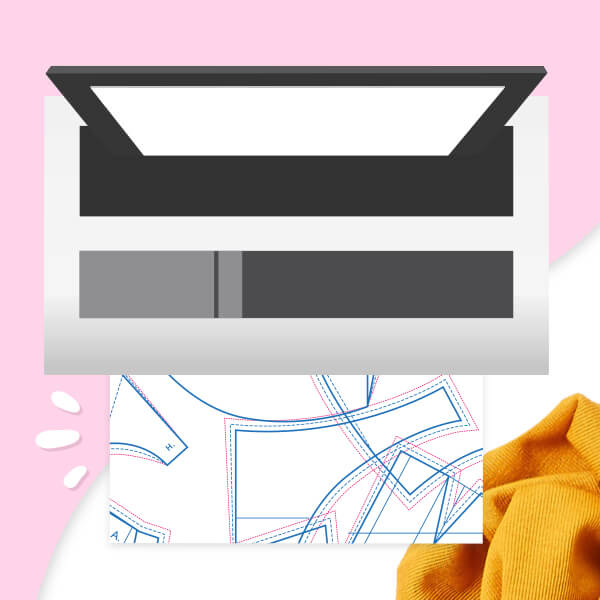Sewing for beginners-tips and resources to get you started
Makerist > Topic pages > Beginner sewing tips > SEWING FOR BEGINNERS - TIPS AND RESOURCES TO GET YOU STARTED
The ultimate beginners guide for sewing
Have you wanted to learn to sew for a long time, but never dared to take the plunge? The time has finally arrived! Discover a new talent buried within you and learn step by step with our top tips for getting started! We have compiled a selection of beginner sewing patterns, a guide to help you choose your fabrics and beginner sewing materials
Become a sewing expert thanks to our simple and accessible content:
Our step by step guide for your first sewing project
How to prepare your pattern
Makerist has a great selection of easy sewing patterns for beginners like you. Once you have chosen a simple sewing pattern suitable for beginners, have enough time, and have armed yourself with patience and kindness to yourself, it is time to start your first sewing project.YAY!

- Remember to choose the right size! There are two possible options depending on the pattern. Either the designer has created a separate pattern file for each size and you simply have to print the correct size for you, or the pattern contains multiple sizes in one file layered over on another (one for each size) and you will have to cut along the line that relates to your size. To choose your size, take your measurements and refer to the pattern size chart if there is one.

- The next step is to cut your pattern including the seam allowances.Many patterns already have seam allowances included: if so, it will be clearly stated in the instructions. Otherwise you can add on your desired seam allowance yourself (we suggest a standard 1cm, although some people prefer a larger allowance to allow for more complex seam finishes like french seams). If you own a set square, quilters ruler, or a regular clear ruler, this can be helpful for adding seam allowance as it allows you to see the edge of the fabric through the clear plastic.
- When tracing off the pattern you can either pin the pattern directly to your fabric, or weight it down to keep in place (using a jar filled with rice, can of beans, or other heavy home-items) and trace around the pattern piece using chalk or a fabric marker. .
- We recommend tracing your pattern onto the WRONG side of the fabric, that way if you make any errors during the tracing process they won’t be visible on the finished piece. Using chalk or a water-soluble fabric marker is also helpful as these marks will disappear after the first wash.

How to prep and cut your fabric
Choose a beginner friendly fabric. (some of the easiest fabrics to handle include: quilters cotton, cotton twill, linen, and other cotton/linen blends. Stay away from satins, silks, & velvets, as well as stretch fabrics if this is your first time sewing).
- It’s always good practice topre-wash your fabric before sewing, fibers often shrink up to 15% after the first wash.
- Always pre-wash your fabric at the same temperature and with the same detergent you plan on washing it with after you’ve finished sewing.
- Make sure you cut your fabrics on grain.. The ‘grainline’ is the warp or weft threads running along the fabric. For woven (non-stretch) fabrics, you generally cut on grain by arranging your pattern pieces parallel to the cut edge of the fabric.
- Match the grain of the fabric to the grainline on the pattern.. Grainlines on patterns are generally indicated by a long arrow extending the length of the pattern piece.
- Choose a suitable work surface. such as a large dining table or a hardwood floor. Soft surfaces, or smaller surfaces where you need to move your fabric around make you more prone to errors during the cutting phase.
- Use sharp, fabric-appropriate scissors.. Fabric scissors are key to cutting out fabric. Kitchen scissors or craft scissors are often not sharp enough to cut fabric across the entire length of the blade, and make it harder to accurately cut out pieces that have curves or smaller elements. .


When it's time to sew
Measure twice, sew once!
- Pin your pattern pieces together before sewing!. Even simple pieces can stretch a little during the sewing process and you may find piece A is longer than piece B by the time you get to the end of the stitch. Save yourself the headache and pin your pieces together at the start, end, and in the middle before starting
- Use the right stitch & stitch length on your machine.For non-stretch general sewing, you use a straight stitch. We recommend starting with a mid-length stitch for beginners as smaller stitches are hard to rip out if you make a mistake, and longer stitches can lead to gapping in your seams. If you’ve just bought a sewing machine, use the settings straight out of the box, or consult the manual.
- Do a stitch test on some scrap fabric! Before leaping into sewing your first seam, sew a line of stitches along two pieces of scrap fabric to confirm your machine is using the right settings for your fabric. Some common signs your machine is on the wrong settings include: wrinkling, visibly loose stitches, having trouble removing the test fabric from the machine, or skipped stitches.

Use a thread the same colour and fiber as your fabric. For a blue cotton, we recommend using a blue cotton or cotton/polyester thread to sew. Back-tack your seams at the start and end! Sew about a centimeter forward and back a few times to ‘lock’ your stitches into place, sew the rest of the seam as normal, and repeat at the end. This will stop your seams unravelling once you’ve finished sewing.












